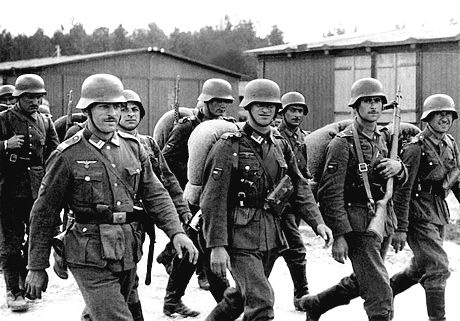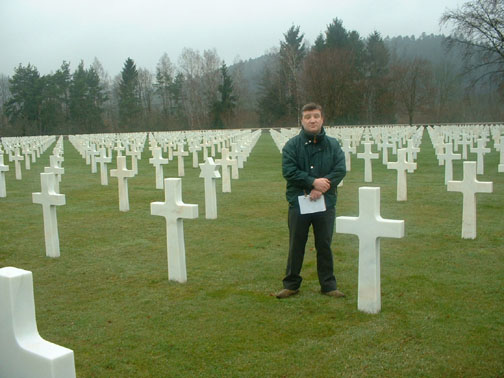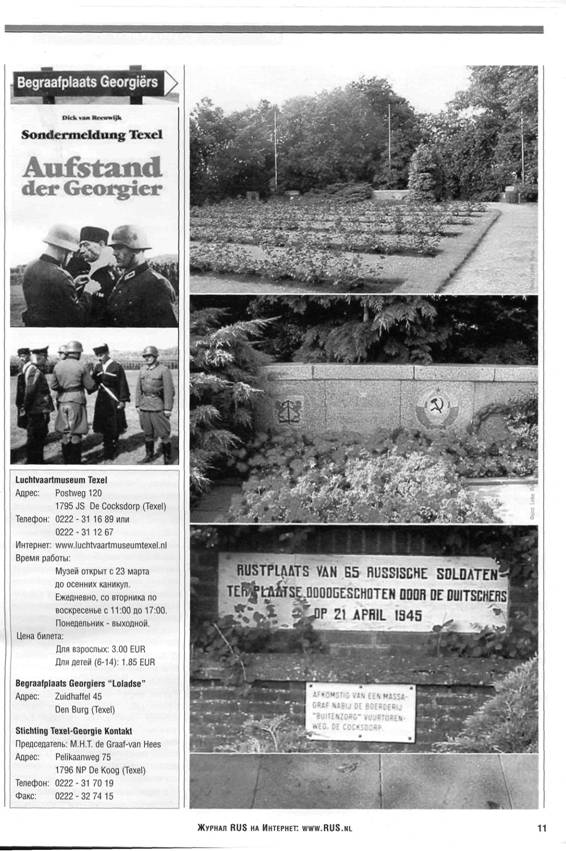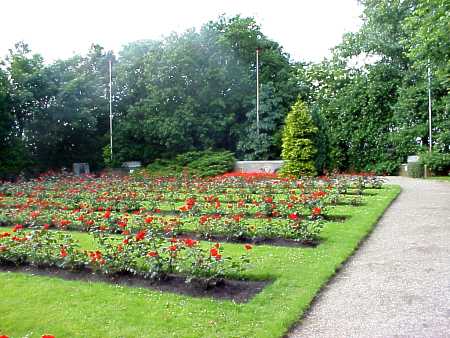Continued from Texel Georgians Russian POW page one
Meantime.....all individual East-bound repatriations are important but the Texel Georgians are important in a number of ways:
(i) their Mutiny and Partisan Campaign on the Dutch island of Texel began on 06 April 1945. They withdrew from fixed positions on 21 - 23 April and they were still fighting, as Partisans, when the Canadians arrived on 20 May 1945, two weeks after the cessation of hostilities on the Dutch mainland.
(ii) they refused to voluntarily disarm and leave Texel until the Canadians spoke on their behalf to the Soviet authorities. The local Canadian commander was so impressed by their resistance efforts that he refused to class them as enemy personnel and treated them at all times as Displaced Persons. They did not have to disarm until their evacuation to Wilhelmshaven on 16 June 1945. Even then, officers were permitted to retain side arms.

Photo on left: 822nd Georgia Battation
On that day:
(i) over the signature of the 1st Canadian Corps commander, Major General Foulkes, the 1st Corps
Civil Affairs staff officer, Lt. Colonel Lord Tweedsmuir, wrote directly to the Soviet High Command.
He praised the Georgians as valiant Soviet allies whose rebellion had resulted in over 2300 German
casualties. He also requested that the Red Army receive the Georgians as heroes and that they be
immediately rehabilitated. This letter seems to have circumvented the HQ Civil Affairs divisions of 1st
Canadian Army, 21 Army Group and SHAEF...to have been a breach of the British policy of minimal interference in Soviet handling of repatriation operations
(ii) Lord Tweedsmuir accompanied the Georgians to Wilhelmshaven and spoke on their behalf to Soviet Liasion Officers in that city.
The Georgians' rehabilitation did not occur until 1955-56. When they were transferred to Soviet custody in 1945 (but WHERE? WHEN?), they were handed over in the company of North Caucasians and were 'almost shot' by Soviet guards. However, most of them did safely return to Georgia. The main body of Georgians are known to have been in Goldberg, Poland, from 12 September 1945 and to have transferred to Volkovysk, Belarus, circa the last week of November. They arrived at an as yet unidentified camp near Baku, Azerbaijan, some time in 1946. I assume that, enroute to the Black Sea, they were also at a camp in Ukraine ? Perhaps the same Transit Camp in which the 4 Mundesley Georgians, see below, were held?
I have very few details about the following but a few of the main group were apparently sent to punishment camps. This caused ill-feeling when these men were released and returned to Georgia where they found the others very much afraid to discuss their repatriation and strongly influenced by the former Secretary of their Battalion's Party Committee.
At least four of the Texel mutineers did go to Siberia (sic)..
On the third night of the Mutiny ten Dutchmen stole the Texel lifeboat, 'the 'Joan Hodshon', and sailed
the vessel to Mundesley in Norfolk, England. With them were 4 Georgians. Their mission was to deliver letters: (i) to Allied commanders in London, seeking military help and supplies for the mutineers and bombardments of Texel's two coastal batteries, and
(ii) to the Soviet Ambassador pledging the 822nd Georgia Battalion's continued loyalty to the Red Army and the USSR and requesting the Soviet Government to urge Allied support for the Mutiny. The mission failed. The Allies sent only a single reconnaissance aircraft.
After a brief interrogation, the Dutchmen and the Georgians were separated. The Dutchmen were given British uniforms and sent by train, that night, 10th April 1945, to London. There, after a brief spell in the Patriotic School screening 'cage' and an interview with a SOE Belgium agent, the Dutchmen were invited to the Royal Netherlands Embassy to meet their Queen.
The four Georgians were also taken to London for further interrogation by Military Intelligence officers. After their friendly enough interrogation they were surprised when the mood changed and they were told that they were being handed over to General Ratov's Repatriation Commission officers. They were taken to Kempton Park camp in Surrey where they were again interrogated by a White Russian officer of the UK Russian Liaison Group.
On 23/24 May 1945, they were told to prepare for repatriation and afterwards sailed to Odessa via Taranto in Italy. This was probably on board, see 'Victims of Yalta', the SS 'Empire Pride' which left Liverpool on 23 May with 2,000 Soviet citizens. Most had been captured in France and had been held in camps in Yorkshire / the North of England.
At Odessa, the four Georgians were held for a short time in that city's nearby Transit Camp (Camp Number? Commander? Guard units ? Details?)and were then sent to Ufa where they were in a labour project camp. From Ufa, they later went to a camp in Komi. I lack numbers and other information about those camps. Nor do I know the dates of their arrivals and transfers.Circa 1948-50 (?), they were released and allowed to go home.
In the summer of 2001-2, only one of the four men, former Segeant Georgi RECHSVIASHVILI, was still alive. He was too ill to be formally interviewed but did speak briefly to an employee of the UK Embassy in Tbilisi. In the 1960's, Georgi apparently wrote a book about his experiences?
The Texel Georgians were only a small part of the Wehrmacht's 30,000-strong Georgia Legion. I am interested in all Georgians in German military /political service but the Texel Georgians are important because they were the subject of several months of 1945-46 high-level diplomatic and military correspondence and because, as noted, the Canadian Army's June 1945 letter to the Soviet High Command seems to have spared them Stalin's wrath? Why, therefore, that small group ? What happened to other returning Georgian 'renegades'?
In 1946, 'Pravda' praised the Texel Georgians as 'Soviet patriots' and as rebelling 'POWs' who had liberated Texel...IN SHORT, THE KREMLIN WAS NOT WILLING TO ADMIT TO THE SOVIET / GEORGIAN PUBLIC THAT WHEN THE MUTINEERS ROSE UP THEY WERE ACTUALLY IN GERMAN UNIFORMS..
In 1953, the Soviet authorities strengthened the 'POWs/liberation myth by commissioning a propaganda movie, 'The Crucified Isle /Island', which featured some former mutineers as actors in a docu-drama about the Mutiny. The film, copy welcome, reportedly repeated these myrths. Even today, I am told, many mutineers' families either do not know or find it hard to believe that their loved ones were 'volunteers' in a German Army pioneer / Grenadier unit.
I am keen to establish a connection with anyone already able to access the Moscow archives and who might be willing, on a reciprocal basis (i.e. I cannot presently afford to pay researchers but can undertake research for overseas helpers here in the UK), to conduct searches there on my behalf.
I am keen, also, to note advice about how I can quickly contact Alexandr Solzhenytsin.
Although several Dutch authors, one or two Germans and a Georgian Professor have written books about the Texel Mutiny none of the Dutch and German books attempts to follow the Texel Georgians beyond the River Elbe.
The Georgian, Russian - language, book, published in the 1960's, gives the information about the Kempton Park, Surrey scenario (also given in a book by Dutch authors Wim Kalkman and Jacques Bartels but independently located by this writer while following up footnotes in 'Victims of Yalta' ) but:
(i) does not name the vessel on which the Mundesley Georgians sailed to Odessa
(ii) does not name the Odessa camp or its commander
(iii) does not mention Ufa or Komi
(iv) mentions the Goldberg and Volkovysk camps to which the main body of Georgians were sent but does not say where they crossed into Soviet-occupied Germany / how they travelled to Goldberg and Volkovysk / what happened to the 12 'missing' men
(v) does not say how the Georgians travelled from Volkovysk to Baku and does not mention Baku.
Oldenburg historian Andreas Lembeck wrote an excellent paper which is the source of my references to the Adelheid - Delmenhorst / Ludwigslust / Magdeburg repatriation convoys' Eastward route. As far as I know, my planned work, for which a Canadian contact is trying to raise funds, is the only one presently tracking the Texel Georgians across Eastern Europe and into their homeland. Again, I emphasise my interest in all Georgian and North Caucasian repatriation convoys.
Also, I am possibly the only writer planning a first-time-ever public study of the Canadian Army's role in the Yalta repatriations. I have the support in principle of the Canadian War Museum and plan an article for the Museum's journal 'Canadian Military History'.
On Texel...476 Georgians lie in the Loladze Georgian War Cemetery....there are no individual grave markers / all but Lieutenant Loladze, the Georgian Commander, are named because Major Breitner, the German commander, destroyed all HQ documents before the arrival of the Canadians on 20 May 1945.
Thank you again for your encouragement!!
Yours Aye, Scottish Alan braveheart562002@yahoo.com
Photo below: Alan Newark during 2002 visit to Epinal US Military Cemetery near Nancy, Vosges Massif, France. Over 2000 US personnel..14 pairs of brothers...Pax Vobiscum..RIP..Ils Ne Passeront Pas
The following attachment is a reply from the US NATIONAL ARCHIVES (NARA) saying that SHAEF G5 & G2 Divisions' decimal indexes for June 1945 hold no refs to the Texel Mutiny or to the 822nd Georgia Battalion. Nor apparently are there any obvious refs in the records of the Fremde Heer Ost, the German High Command and Intelligence department dealing with Osttruppen.
I know from my own studies of UK Public Record Office 21 Army Group files, some of which I later found mentioned in Wim Kalkman's book, and from Andreas Lembeck's 1999 chapter 'Leben in Transit' in Katerina Hoffman's book about zwangsarbeiters and DPs in Oldenburg, that there ARE / WERE SHAEF files relating to the Texel Georgians and that there ARE SHAEF files relating to the Oldenburg Soviet DPs' camp.
As the attachment indicates these might well be in documents within various classes of SHAEF records for whose exploration the NARA staff cannot spare further time or labour.
Scottish Alan,
Alan Newark,
34 Rossefield Parade, Leeds, LS13 3RW, West Yorkshire,
England, UK. braveheart562002@yahoo.com
Attachment from NARA: Dear Mr. Newark,
This is in reply to your inquiry concerning a revolt of a 822nd Georgian Infantry battalion on
the Dutch island of Texel.
The guide to the records of the Fremde Heere Ost does not list the 322 Battalion.
Sincerely,
Mr. R. E. COOKSON "Robin Cookson" robin.cookson@nara.gov
Archivist for Captured German and Related Records
Checking a present-day rail map of North Central - Eastern Germany, I see a rail link between LUDWIGSLUST and a German town named GOLDBERG, south of GUSTROW. Goldberg stands at the junction of road and rail routes linking it with WISMAR, SCHWERIN, LUDWIGSLUST.
Although there is quite some distance involved in the following suggestion, it would have been possible for DPs sent Eastwards from OLDENBURG via MAGEDBURG and / or STENDAL to have travelled northwards to GOLDBERG (MV) by road or rail via TANGERMUNDE ( the known Soviet Exchange Point for STENDAL), PERLEBERG, PRITZWALK and KAROW .
Question ....is there any other town of that name closer to / in the Ciy of STETTIN - SZCZECIN which might be a likelier candidate for the location of the GOLDBERG transit camp named by the Texel Georgians ?
I also have a list of the 1945 Soviet garrison forces known to have been stationed in / near WISMAR, SCHWERIN, STENDAL, LUDWIGSLUST, PLAUEN, MAGDEBURG.....From my own researches, all were used by SHAEF / 21 Army Group / 30 Corps / 8 Corps as Frontier Control Posts for the May - June 1945 Eastward transfer of DPs. I also have details of Soviet troops at PARCHIM, the Soviet Divisional HQ location through which sick and wounded Soviet DPs were routed.
One Allied FCP location not seen in the OOB list of locations was WUSTMARK. Soviet Exchange Points for sick and wounded DPs also included MOLLN and MALCHOW.
Problem..must check with webmaster of above OOB source site as it doesn't state whether forces named are the front-line units, which might have helped the NKVD and SMERSH to process the earliest DPs' convoys, or the replacement units which relieved former during / from July 1945.
Also, the Soviets occupied above WISMAR, STENDAL, MAGEDBURG in July 1945, Did they continue to be used as Exchange Points after the Western Allies' withdrew? If not, to where were DPs sent?
Field Marshal Montgomery's CoS, Major General BELCHEM, CONFUSINGLY wrote in his memoirs that the 'British Zone of Occupation' maintained only a single agreed 1945 crossing point for DPs..the WITTENBERGE railway Bridge...if Belchem's spelling was correct, this had to be WITTENBERGE = probably within the administrative sphere of the Soviet garrison at PERLEBERG.
Remembering that PERLEBERG is also on a direct road route from LUDWIGSLUST and that there is a direct rail route between MAGDEBURG and WITTENBERGE / that PERLEBERG can TODAY be accessed by rail and road, via STENDAL and TANGERMUNDE, as far as HAVELBERG, from where the journey is by road.
Also, was WITTENBERGE used before and after mid-July 1945 or only after re-alignment of
Demarcation Line?
Again, I apologise for not sending this earlier..ref the German Red Cross Archives.
Petra Liebner
German Red Cross
Headquarters / Archives
Carstennstrasse 58
12205 Berlin
Germany
liebnerp@drk.de
Olga,
The photo is of a cemetery (Begrafplaats) burial place named Georgiers. Some of the writing on the left is in Russian, but there is the German portion which I can translate as (Den Burg) the town of Textel.
The bottom photo reads: Resting place of 65 Russian soldiers, (part of the bottom reads) Shot to death (Doodgeschoten) on April 21, 1945.
I believe the bold words on top left may mean , "Stand off at Georgier," which resulted in the death of those 65 soldiers. Take care and keep up the good work!, Margie
B & W pix from: 'Sondermeldung Texel ..Aufstand der Georgiers', by Dick van Reeuwijk, published by Theo Timmer, Het Openboek, Den Burg, Texel Also now in English language version, ' The Georgian Rebellion on Texel', price: 13 Euros (contact: info@hetopenboek.nl / www. hetopenboek.nl).
Texel island, Holland..Begrafplaats Georgiers. Last resting place of 476 soldiers of 822nd Georgia Battalion, KIA during a 1945 mutiny against the island's German Army garrison. All but one of the Georgians, the commander, Lieutenant Loladse, is named, the others being buried in long mass graves.Colour picture from Andy Kelly napalm@usa.net of Yahoo Groups Ostbataillon
2/26/08 Dear Alan,
I knew on your research of Texel Georgians in the 5-years-old web-publication, texel-georgians.html.
Could you find materials which you needed? If yes, is it possible to know some
details on the subject?
I met with this story yesterday by chance and was interested in it because
I live in Ufa (Russia) and work as a journalist.
As I can assess the situation, all that concerns POWs is kept in the FSB (KGB)
archives. It’s hardly possible to get the access to them, I
believe. As I know, German, Magyar, Japanese POWs were kept here in Ufa’s
camps in 1940/50s. Some of the Germans stayed here voluntarily after liberation. But I have now details on this.
Regards,
Irek Sabitov igrek12@rambler.ru

